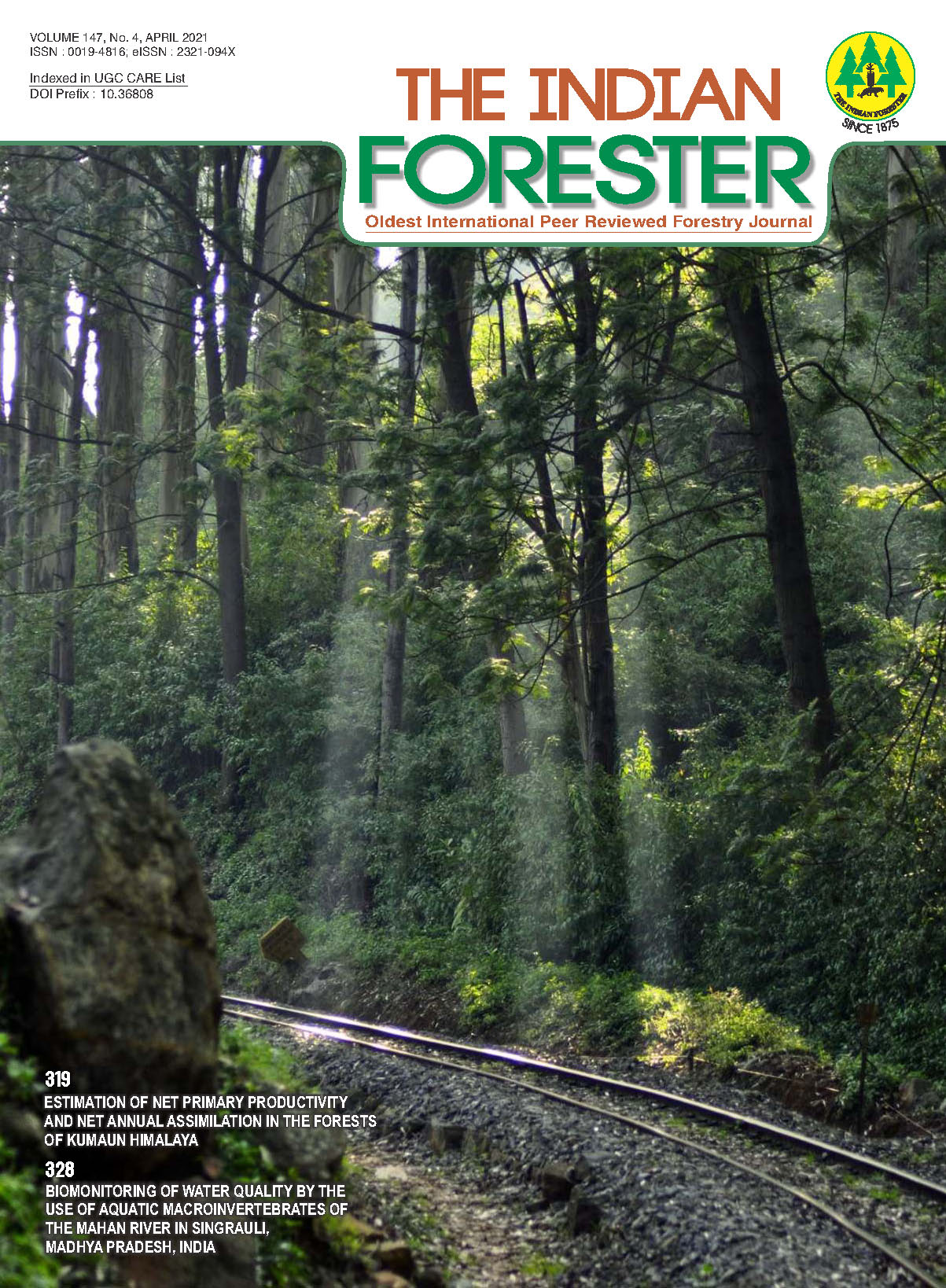Collection and Distribution of Mahua (Madhuca longifolia), Tendu (Diospyros melanoxylon) and other NTFP's in Critical Tiger Connectivity Corridor of Maharashtra
DOI:
https://doi.org/10.36808/if/2021/v147i4/151892Keywords:
NTFP, Tiger, Nagzira, Tadoba, Central India.Abstract
Vidarbha Tiger Landscape in Maharashtra is an important Tiger Panthera tigris tigris connectivity linkage between Central India Tiger Conservation Landscape. The Nagzira Nawegaon Brahmapuri landscape acts as sinks for the Tiger source populations between Tadoba, Pench and Kanha Tiger Reserves from North to South and Vice Versa. These corridors are inhabited with several villages, dependent on the forest resources for subsistence and supplementary income. The major source of supplementary income post agriculture period for villages are collection of Tendu (Diospyros melanoxylon), Mahua (Madhuca longifolia) and other Non-Timber Forest Produces, also the trigger points for human wildlife conflict. Several programmes on reducing dependence on forest resources are implemented in these connectivity corridors by government agencies and Non-Government Organizations. This study from Vidarbha Landscape, first time documents collection and distribution of two of the most collected and other selective NTFP tree species in village common and agriculture areas, between the two Tiger connectivity corridors; Nagzira Nawegaon Tiger Reserve and Brahmapuri Forest Division near Tadoba Andhari Tiger Reserve in Maharashtra. The findings of study indicate marginal landholders and landless more dependent on collection of these resources. The findings of the study contribute towards developing inclusive corridor and conflict management plan for both the regions.References
Census 2011.co.in. (n.d). Maharashtra Population Sex Ratio in Maharashtra Literacy Rate Data 2011-2020. [online] Available at: https://www.census2011.co.in/census/state/ maharashtra.html> [Accessed 1 March 2020].
FAO. (2008). Non-Wood Forest Products, Rome, Italy.
GFAR Global Partnership Programme (GPP) on Non-timber Forest Products (NTFPs) for Livelihood Development. (2005). International Network for Bamboo and Rattan. [online] Available at:http://www.fao.org/docs/eims/upload/210364/done NTFP04report.pdf.[Accessed 19 February 2020].
Hansda R. (2009). The outlook for Non Wood Forest Products in Asia and the Pacific, Working Paper No. APFSOS II/WP/2009/18. Food and Agriculture Organization of the United Nations Regional Office for Asia and the Pacific, Bangkok.
India State of Forest Report. (2017). [online] Available at: http://fsi.nic.in/isfr2017/isfr-forest-cover-2017.pdf. [Accessed 14 January 2020].
Jhala Y.V., Qureshi Q., Gopal R. and Sinha P. R. (Eds.) (2011). Status of the Tigers, Co-predators, and Prey in India, 2010. National Tiger Conservation Authority, Govt. of India, New Delhi, and Wildlife Institute of India, Dehradun. 302 p.
Mishra S. and Sarojini P. (2013). Madhuca longifolia (Sapotaceae): A Review of Its Traditional Uses and Nutritional Properties Mishra in International Journal of Humanities and Social Science Invention. pp. 30-36.
Muthyalu M. (2008). Collection and marketing practices of non - timber forest produce (NTFP) - An empirical analysis, Blue Ocean Research Journal,2(1): 121-130.
Pinakin D.J., Kumar V., Kumar A., Gat Y., Suri S. and Sharma K. (2018). Mahua (Madhuca longifolia): A Boon for Pharmacy and Food Industry, Current Research in Nutrition and Food Science Journal, 6(2): 371-381.
Qureshi Q., Saini S., Basu P., Gopal R. and Jhala Y. (2014). Connecting tiger population for long term Conservation. Dehradun, Wildlife Institute of India and New Delhi, National Tiger Conservation Authority.
Sanderson E., Forrest J., Loucks C., Ginsberg J., Dinerstein E., Seidensticker J., Leimgruber P., Songer M., Heydlauff A., Oâ€Brien G., Klenzendorf S. and Wikramanayake E.(2006).Setting Priorities for the Conservation and Recovery of Wild Tigers: 2005- 2015. The Technical Assessment. Wildlife Conservation Society, World Wildlife Fund, Smithsonian and Save the Tiger Fund, Washington, D.C.
Shrey R., Acharya G.K. and Dhurwey C.K. (2018). Economic Impact of Mahua (Madhuca longifolia) (Madhuca longifolia) (Madhuca spp.) on Tribal Livelihood and Its Marketing in Chhattisgarh State, International Journal of Current Microbiology and Applied Sciences. pp.3595-3601.
Sinha G.K. (2008). An economic analysis of collection and marketing of non-timber forest Products in Kanker district of Chhattisgarh. Postgraduate dissertation, Indira Gandhi Krishi Vishwavidyalaya, Raipur (C.G.). pp.123-124.
Kallepelli R. (2019). Forest Department considering translocation of Tigers, Leopards to curb man animal conflict incidents. Vidarbha Line, The Hitvada. 24th June.
Yumnam B., Jhala Y.V., Qureshi Q., Maldonado J.E., Gopal R., Saini S., Srinivas Y. and Fleischer R.C. (2014). Prioritizing Tiger Conservation through Landscape Genetics and Habitat Linkages. PLoS ONE, 9(11): doi:10.1371/journal.pone.0111207.
Downloads
Additional Files
- Requires Subscription Untitled
- Requires Subscription COLLECTION AND DISTRIBUTION OF MAHUA MADHUCA LONGIFOLIA, TENDU DIOSPYROS MELANOXYLON AND OTHER NTFP’s IN CRITICAL TIGER CONNECTIVITY CORRIDOR OF MAHARASHTRA.
- Requires Subscription COLLECTION AND DISTRIBUTION OF MAHUA MADHUCA LONGIFOLIA, TENDU DIOSPYROS MELANOXYLON AND OTHER NTFP’s IN CRITICAL TIGER CONNECTIVITY CORRIDOR OF MAHARASHTRA.
- Requires Subscription Untitled
- Requires Subscription Untitled
- Requires Subscription Untitled
- Requires Subscription Untitled
Published
How to Cite
Issue
Section
License
Unless otherwise stated, copyright or similar rights in all materials presented on the site, including graphical images, are owned by Indian Forester.





